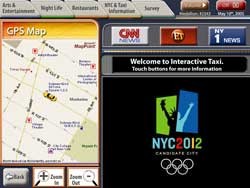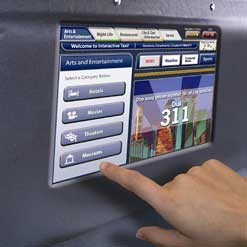Article
Interactive taxi kiosks deliver information, entertainment
Cab riders in some major cities may find that making their way around a metropolis has just gotten easier, thanks to the emergence of new interactive taxi kiosks.
October 30, 2005
Where's the best Chinese restaurant in the city? Did the Patriots win? What shows are playing this week? Is there a Starbucks nearby? Any good news from the stock market? Is it going to rain all day? What about tomorrow?
Taxi drivers have long fielded an array of questions from travelers. And even though they are tough to stump, every now and then they could use some help.
Enter the interactive taxi kiosk.
Appearing in ever-growing numbers in Boston, Chicago and San Francisco, and soon to be in Charlotte and New York City, interactive taxi kiosks put an abundance of information at a customer's fingertips. The tablet-like devices are mounted either in the headrests or in the partition between the driver and passenger and consist of a wireless computer that is capable of delivering multimedia content.
Passengers interact with the kiosk via a touchscreen to retrieve up-to-the minute local and national news, sports, weather, local area information and more. A scrolling ticker keeps riders abreast of stock market activity.
"The kiosks are informational and entertaining," said Cory Gottlieb, chief executive officer of Interactive Taxi. "Passengers can use a Yellow Pages-like directory to search for restaurants, nightclubs, movie listings, area attractions, and city resources for free. The systems also are hooked up to the Office of Emergency Management and the Amber Alert System."

Companies listed can opt to provide more in-depth information for an advertising fee. When passengers click on an advertiser's link, a micro site opens on the left-hand side of the screen into a full sight, sound and motion commercial that details specific information that the advertiser has requested.
"The unit offers the immediacy of a TV spot, but with the depth of the Internet," said Gottlieb. "Advertisers have the opportunity to reach a captive audience."
 This story and all the great free content on KioskMarketplace is supported by: Looks Cool, Runs Cooler  |
Fortunately for passengers, they have complete control. They can adjust the volume or turn off the device entirely.
In the near future, the kiosks will even include credit card swipe functionality so that passengers can pay for their cab ride with a credit card and even order and pay for movie tickets using the touchscreen.
"It gives passengers something to do," said Nathan Dwiri, president of the San Francisco Yellow Cab Cooperative. "Instead of asking drivers, `Where's a good place to eat?', they can find it for themselves."
The cooperative has just recently begun utilizing the interactive devices and initially plans to install the units in 75 of its 469 cabs.
San Francisco's Luxor Cab began a slow rollout of the devices in the spring and has installed the devices in 100 of its 240 cabs. Plans are to eventually include the units in 125 cabs.
John Lazar, president of Luxor, said one issue facing the industry is educating the public. "Literacy of the people to figure out how to use it is important to its success."
Thanks to a mandate from the New York Taxi and Limousine Commission, passengers in New York City won't have to search for a cab that offers the kiosks. It is projected that by the end of the first quarter of 2006, all cabs in the city will be required to have these devices - just as they have to have a meter.

Behind the scenes
Interactive Taxi LLC, a wholly owned subsidiary of Targeted Media Partners, has been involved in designing, installing and distributing the hardware in Boston, Chicago and San Francisco for several years and has been part of the device's evolution.
Gottlieb said the kiosks use Peer Direct, a file replication software from Progress Software Corp. to keep the systems synchronized. The unit's two-gigabyte flash drive runs on Windows XP and receives updates from a central database.
"The system relies on a network operation center or hub that knows the content that each cab should have," said Gottlieb. "Every five minutes the system checks to see if there are any updates."
This type of collaboration prevents users from experiencing any downtime in case the cab should enter a tunnel or other dead zone.
A few kinks yet
Not everyone is taken with the new devices, and early adopters of the technology are coping with some challenges.
Minutes from the April 12, 2005, meeting of the San Francisco Taxicab Commission express concerns that the kiosks are worsening the conditions for drivers because the drivers have to listen to the same content all day.
Lazar had a few drivers ask to have the kiosks removed because of noise problems and customer complaints of the device taking up too much space. But overall, customers and drivers have been happy with the units, he added.
Lazar is optimistic that Interactive Taxi will eventually get all the kinks worked out. "It's a good product Â… I think it will be good for ridership and the revenue gained."











